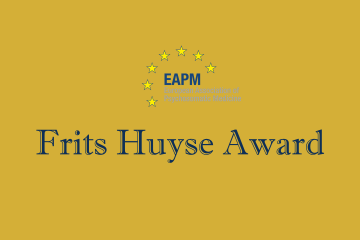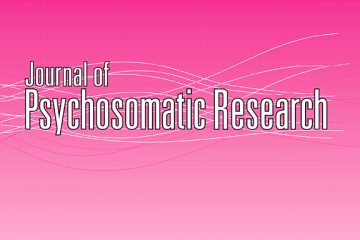The Editor’s choice October 2023
written by Jess G. Fiedorowicz, Editor-in-Chief, Journal of Psychosomatic Research, Professor and Senior Research Chair in Adult Psychiatry, University of Ottawa, Head and Chief of Mental Health, The Ottawa Hospital Scientist, Ottawa Hospital Research Institute, and Antonina Mikocka-Walus, Deputy Editor, Journal of Psychosomatic Research in October 2023.

Jess Fiedorowicz, JPR’s Editor-in-Chief
The Editor’s Choice –
“Explanatory models for persistent somatic symptoms”
This quarter’s Editor’s Choice presents a unique study designed to address relevant assumptions in psychosomatic medicine that are seldom tested. The study ”Helpful explanatory models for persistent somatic symptoms (HERMES): Results of a three-arm randomized-controlled pilot trial” by Angelika Weigel, Paul Hüsing, Magdalena Junge and Bernd Löwe1 piqued our interest as it sought to directly test the impact of having a theoretical model of persistent somatic symptoms, with or without personalization, against a no explanatory model control group on somatic symptom severity and psychological burden. Theoretical models are ubiquitous in psychotherapy and can provide the framework to understand the condition and plan treatment. The underlying etiological theories can also inspire additional techniques that can be tested. Having a particular theoretical frame may also engage patients, particularly when that theoretical framework can be individualized or personalized to the clients unique lived experience, preferences, and needs. Studies testing the effectiveness of psychotherapies based on some theoretical model are the norm. Rare are studies designed to test the value of the etiological model or whether personalization of the therapy to that model influences outcomes. HERMES is unique in having been designed with this in mind. Angelika Weigel and her collaborators from Hamburg, Germany concisely summarize their findings in the following passage:
For persistent somatic symptoms (PSS), shared symptom explanations between patients and healthcare providers are considered crucial, but their impact on patient outcomes has not been tested. Therefore, the HERMES study tested the efficacy of tablet-based explanatory models for PSS with and without personalisation compared to a control group in a 3-arm randomised controlled trial with 75 outpatients with PSS. Somatic symptom severity and psychological distress were the primary outcomes, which did not differ significant between groups after one month. However, participants who saw an explanatory model with personalisation rated individual fit highest. Personalisation in PSS patient education seems promising.
HERMES estimated having 78% power to detect even small differences between groups, although these estimates are likely optimistic for a study with only n=25 in each group. Based on the more limited assumptions of an independent samples t-test, a comparison of two groups of 25 would have 80% power to detect a large effect size of 0.81 SD with an alpha of 0.05. It is not clear, however, that the negative results for the primary outcomes of the study can be merely explained away by limited power. Interestingly and contrary to the authors hypothesis, the group that did not receive an explanatory model had, if anything slightly better outcomes although this did not remotely approach the threshold of statistical significance as shown in Table 1. The no explanatory model group received generic information about German guidelines for persistent somatic symptoms.2
| No explanatory model (n=25) | Explanatory model without personalization (n=25) | Explanatory model with personalization (n=25) | |
| Change in PHQ-15 | 4.1 (2.3-5.7) | 3.3 (1.4-5.2) | 2.1 (0.3-3.8) |
| Change in SSD-12 | 6.0 (2.8-9.3) | 4.8 (1.2-8.4) | 4.9 (1.5-8.3) |
| Table 1. Primary outcomes of HERMES by study arm.
Statistically significant differences were not observed for any contrast between groups for the co-primary outcomes: change in PHQ-15 (Patient Health Questionnaire 15) and the SSD-12 (Somatic Symptom Disorder B-criteria scale 12). Adjusted mean sores are shown with a 95% Confidence Interval with a positive number corresponding to a reduction in symptoms. |
|||
The interventions were quite brief (15 minutes) and administered on a tablet computer. This brief duration and method of implementation was selected given that successful implementation to meet the broad needs of the population requires a focused, disseminatable intervention. In the personalization group, after exposure to the explanatory model, participants could receive further information related to one of three mechanisms of symptom perception that they chose based on perceived personal relevance. Participants had access to treatment as usual in the clinic or community, which included group or individual psychotherapy. One might wonder if the effects observed would be different if the explanatory model was embedded within some ongoing treatment, which would otherwise only differ based on the presence or absence of the explanatory model or the personalization of this model. This would obviously require a much more involved and expensive study and at the expense of the authors decision to choose a simple intervention that could rapidly be scaled.
While there were no differences in primary outcomes, the group that had the opportunity to personalize a portion of the intervention rated the perceived fit of the information to be higher on a visual analogue scale. The authors keyed in on this as a potential benefit of personalized interventions. They also noted several important limitations that may have influenced the results including the recruitment of a sample with complex illness from their tertiary center and the long duration of follow-up. We hope that HERMES and what we have learned from its design, inspires further study of this research question. We would be delighted to feature any such work in the Journal of Psychosomatic Research. Our selection of HERMES for Editor’s Choice, underscores our emphasis on innovative study designs and our commitment to publishing such studies regardless of whether the primary results are positive or negative. We encourage you to review the full paper and discuss with your peers. Perhaps the work that it inspires will be yours.
REFERENCES:
- Weigel A, Hüsing P, Junge M, Löwe B. Helpful explanatory models for persistent somatic symptoms (HERMES): Results of a three-arm randomized-controlled pilot trial. J Psychosom Res 2023;172:111419. (In eng). DOI: 10.1016/j.jpsychores.2023.111419.
- Roenneberg C, Sattel H, Schaefert R, Henningsen P, Hausteiner-Wiehle C. Functional Somatic Symptoms. Dtsch Arztebl International 2019;116:33-34.




0 Comments